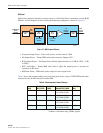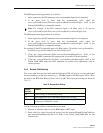
ADCP-75-192 • Issue 2 • June 2007
Page 49
© 2007, ADC Telecommunications, Inc.
4.2 Upgrading an Existing System
The most common upgrade scenario is one where an existing, fielded, operational system is
having all of its CPUs upgraded to the next version of software.
4.2.1 Preliminary Steps
The following are some general notes that need to be considered when upgrading a fielded
system:
• The Hub Master should be the final CPU upgraded in the network to ensure that any new
network-level functions are managed and supported properly.
• It is assumed that a network administrator will be performing the upgrade.
• Upgrading an operational system will interrupt service, so upgrades should be planned
during the maintenance window.
• An upgrade of a test CPU should be attempted prior to upgrading an entire system or set of
systems.
• For upgrade verification purposes, note the PA power, RUC attenuator values, and module
pathtrace values (see the transceptOpencellPathtraceTable MIB) on a test RAN CPU and
follow instructions found in the section in this document labeled “Verification.”
• The upgrade executable should be FTP'd to all target machines prior to upgrading any
machine. This is more efficient than updating one machine at a time.
• The RAN CPUs should be upgraded first, as upgrading the HUB CPUs may interrupt
telnet sessions to the RAN, thereby stopping the RAN upgrades.
4.2.2 Upgrade Steps
The upgrade steps are found in the Release Notes for that software version release.
4.2.3 Verification
It is important to be sure that the upgrade was successful before continuing on with upgrading
other CPUs in the network. Some of this verification is done automatically by the upgrade
executable, but there are certain steps that need to be done manually as well.
• Actions that are automatically taken by the upgrade executable to verify success include
the following:
• Built in package management checks to be sure that files are being written and removed as
expected.
• Checks to be sure that upon completion of the upgrade, certain processes are running (or
no longer running, as the case may be) as expected.
• Test scripts being run to ensure that processes are running as expected.


















